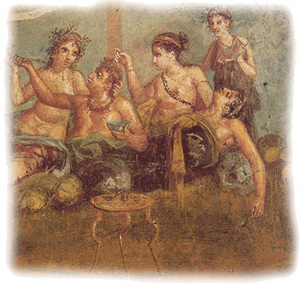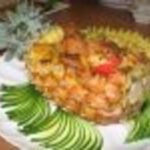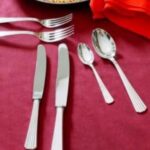Roman banquets were impressive and opulent affairs that would be difficult to surpass today. The ancient Romans of the upper classes enjoyed their daily comforts, and dining was just a natural extension of that.
A Roman dinner party for the wealthy would begin right after the bath. Dinners like these were held on something impressive called a triclinium. A triclinium had three long couches that were centered around a long, rectangular table and allowed the Romans to dine in comfort. Very special guests and the host were situated immediately across from the open end of the table on the lectus medius. The other two couches were called the lectus imus and the lectus summus.
Nine people attended these dinner parties with three people each to a couch. One reason that Roman dinner parties usually had nine guests was to honor the nine muses who were goddesses of the arts and sciences.The Roman diners would lay sprawled upon their stomachs on these couches and lean on their left elbow, and only children would be allowed to eat in a seated and upright position. Food and drinks were brought to the Romans by servants, and usually one side of the table would be left empty for food service. Garlands of rose petals were worn around the heads of the guests to soften the effects of drinking too much wine.
In 60 A.D. Petronius talked about his eating experiences and the triclinium. “After a generous rubdown with oil, we put on dinner clothes. We were taken into the next room where we found three couches drawn up and a table, very luxuriously laid out, awaiting us. We were invited to take our seats.”
There were some Roman dining rooms that had ceilings made of fretted ivory so that when the panels were pulled back, flowers or perfume could be showered upon the guests. But some of the experiences of Roman diners must have been even more profound. Those who were invited to dine alongside the Emperor Nero were treated to an ornate dining room that had a revolving ceiling which turned day and night, in perfect time with the sky outside.
Before the start of the meal, an offering was made to the Lares, the household gods. Once the offering was made, the meal would begin.
The elaborate dishes served at Roman banquets was usually quite extravagant. Meat dishes included choices like boar, wild goat, venison, lamb, mutton, sucking pig, dormice and hare. When it came to poultry, the choices were seemingly endless. There was chicken, ostriches, cranes, geese, duck partridges, pheasants, doves, pigeons, fig-peckers and thrushes. Peacocks were reserved solely for the very wealthy. It was normal to have one main delicacy, like a sturgeon for instance, which was brought into the room by a large procession of slaves playing the flute.
Some of the other foods that were eaten were snails that had been so fattened by milk that they were unable to enter their shells any longer.
A sample of some Roman starters for the meal might include jellyfish and eggs, sow’s udders stuffed with milk and eggs, boiled tree fungi with peppered fish fat sauce or sea urchins with spices, oil and egg sauce.
The main course might consist of fallow deer roasted with onion sauce, rue Jericho dates, raisins, oil and honey. Turtled dove boiled in its feathers went over well with guests as did ham boiled with figs and bay leaves, and then rubbed with honey and baked inside of a pastry crust. For those who favored birds and weren’t crazy about doves, parrots were often roasted and flamingos were boiled with dates.
For dessert, hot African sweet wine cakes could be served with honey. Another dessert choice might be stoned dates which were stuffed with nuts and pine kernels, and were then fried in honey.
More in depth descriptions on Roman banquets were given by Petronius in The Satyricon. On the hors d’oeuvres tray stood a donkey of Corinthian bronze bearing saddlebags stuffed with olives, white in one side, black in the other. Two platters flanked the animal; their weight in silver and Trimalchio’s name were engraved along their edges. Little bridges welded to the plate supported dormice sprinkled with honey and poppyseeds. There were even sausages sizzling on a silver gridiron, which arched over some Syrian plums and pomegranate seeds.
On a round serving tray the twelve signs of the zodiac were arranged in a circle. Over each sign the specialty chef had placed the kind of food that fit its character; over Aries the ram, a ramifying pea; on Taurus the bull, a slice of rump roast; over Gemini the twins, testicles and kidneys; on the Cancer the Crab, a crown of flowers; over Leo the lion, a virile African fig; on Virgo, the womb of a barren sow; over Libra, a set of scales with a cheesetart on one side, balanced by a pancake on the other; on Scorpio, the scorpion fish; on Sagittarius, a seahorse; on Capricorn, a lobster; on Aquarius, a goose; on Pisces, a pair of snappers.”
If you were really lucky, you just might find gold, pearls, amber or other jewels hidden amongst the food dishes.
The dinner length all depended upon who was having the banquet. It was not uncommon for Roman banquets to last for eight to ten hours. It was also not uncommon for dinner guests to stuff themselves so full of food that they were ill afterwards.
An indicator that the dinner had gone well would be if guests asked for bags of leftovers to be taken home. This was one way that the host would know that the food had been enjoyed and that his dinner had been a great success.
Sources: www.vroma.org/~plautus/foodweise.html, www.romans-in-britain.org.uk/arl_roman_cooking-pt1.htm, www.dl.ket.org/latin1/things/food/banquet.htm







